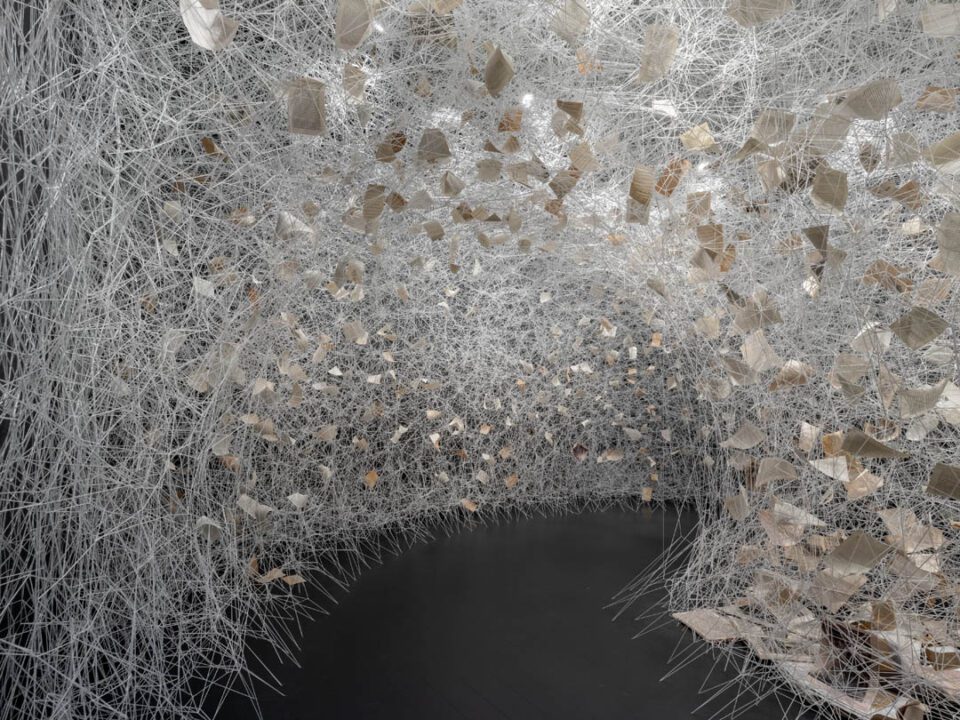Books. Pianos. Window frames. Suitcases. Clothes. These are just some of the items to be found tied up within Chiharu Shiota’s (b. 1972) mesmerising installations. The Berlin-based, Osaka-born artist is perhaps best known for The Key in the Hand, Japan’s 2015 Venice Biennale Pavilion, which entangled 50,000 keys in bright crimson thread. Now, a series of new installations opens at New York’s Galerie Templon. The exhibition – titled Signs of Life – is based around the idea of collective memory and shared knowledge. It comprises ethereal sculptures and signature room-sized works, in which clouds of shining white yarn intertwine, knot and obscure the space. The result: a tangle of hypnotic passages and caves.
A: The current Galerie Templon show, Signs of Life, centres around the idea of the “web”. It’s a word that suggests an array of associations – from the The World Wide Web to structures made by spiders. Can you tell us more about this concept, and why you’ve chosen it? CS: It is all about connection. I believe that everybody in society is connected with an invisible line, and I want to make this link visible. I used books on art history for the installation at Galerie Templon: different parts of the story of art are joined together with white string, overlapping until you cannot follow the line with your eye anymore. The title Signs of Life, meanwhile, relates to the significance of human writing – in books, letters and diaries.

A: Your works often incorporate objects, such as salvaged window frames, a piano, suitcases, books and used clothes. What’s the story behind these items? Where do they come from, and which objects are enfolded in your latest sculptures? CS: I collect all the items from flea markets. In Berlin, for example, there are so many objects to discover. Sometimes I can find an old passport, diary or suitcase. Recently I found a diary from 1946. Someone wrote in it just after the war; I can imagine that, at the time, there was nothing in Berlin and everyone had to start again. This person wrote everything down. I never met them, but I have a feeling I know them. All my found objects have lots of memory inside of them, and I can feel their presence. This is the theme of my work: existence in absence.
A: You have an interdisciplinary background: a foundation degree in painting, followed by a period of performance. Now, you work on site-specific installation and sculpture. When did you start working with thread? Why do you return to the medium again and again? CS: I wanted to be a painter. I went to art school but, when I was in my second year, I felt like nothing I painted was original. It didn’t feel like my work. Everything had been done before, and I couldn’t continue working in that space. Then, I started to use thread to make lines in the air. It felt like drawing. The thread was was like a pencil line and I was drawing in the whole room. In this way, my installations are like paintings.
A: It took two weeks to install this installation. What does the process of putting together such a large-scale, intricate work look like? CS: It took almost two weeks. You have to start at the ceiling, then move down and all around the space. It is quite difficult to concentrate and keep the tension for so long, but it sometimes feels like meditation.

A: In 2015, your Japanese Pavilion was a focal point of the Venice Biennale. Ephemeral, immersive installations have since become your signature, and are especially popular in the age of social media. Why do you think they resonate with people? CS: People see my work and then they ask how long it takes. It’s a lot of work. It looks like it’s impossible – as if it took forever to weave. People ask for the number: how many days, how many people, how much thread…. This is always the first question. Then, later, they start to question the concept and slowly think about how the work makes them feel. I don’t know what resonates with people specifically, but I was very happy about the Venice Biennale pavilion and that it was so popular. I had put all my energy into that piece, everything I had. It was so much work. I was pleased to see so many viewers connect with it.
A: This is your first New York show for almost a decade. What’s next for you? CS: I haven’t had a show in New York, but my work has been displayed across the USA: at the Smithsonian in Washington, for example, and at MOCA Jacksonville. I’ve also had installations worldwide. Right now, my solo exhibition The Soul Trembles is touring through Asia-Pacific, and my next show is at the Hammer Museum, Los Angeles.
templon.com | Signs of Life until 9 March
Words: Eleanor Sutherland
Image Credits: Chiharu Shiota, Signs of Life Exhibition Views, Templon, New York. Photo: Charles Roussel





